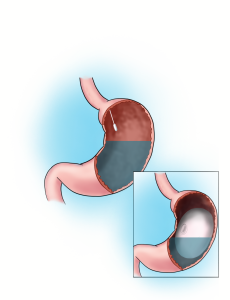Intragastric balloon system

Intragastric balloon systems have been known in the world since 1985. Initially, they were associated with several complications. With the improvement of materials and technologies, it has become a safe and minimally invasive or non-invasive method. The volume of the stomach is 1200 ml, it can be three times larger for obese people. Though, a 500 ml balloon is enough to feel full. Most of the time, the balloon is placed endoscopically under light anaesthesia (sedation). The balloon system used at International Bariatric Center of Excellence (IBCE) of AIWA Clinic is non-invasive. During the procedure, a capsule with a catheter is inserted through mouth into stomach. After the balloon inside the capsule has been swallowed, an X-ray check is done to make sure the capsule is properly placed. Then the balloon is filled with 550 ml of a neutral solution – this is how a “full stomach” or feeling of satiety is achieved. To make sure that the balloon is fully inflated, the X-ray is repeated.
The procedure lasts less than half an hour. There is no need to stay in the hospital after the manipulation. Four months after procedure, the valve in the balloon dissolves, and the solution with the empty balloon leaves the digestive tract naturally.
![]() The intragastric balloon is not intended for patients who have undergone stomach and intestinal operations, including bariatric surgery, who have severe liver, kidney, lung failure, pregnancy, large diaphragmatic hernia, as well as for patients with normal weight.
The intragastric balloon is not intended for patients who have undergone stomach and intestinal operations, including bariatric surgery, who have severe liver, kidney, lung failure, pregnancy, large diaphragmatic hernia, as well as for patients with normal weight.

Benefits
- Fast and effective way to lose weight. A meta-analysis of the research data shows that, within four months, the patient loses in average 10-14% of total weight and 30-67% of excess weight.
- The balloon is made of vegan polyurethane, which is thinner and more flexible than silicone.
- This is an option of weight loss before a bariatric surgery if the patient weighs more than 200 kg or if the surgery is contraindicated due to high surgical risk.
- The patient has a regular feeling of full stomach, appetite reduces. In addition, food stays in stomach for longer.
- Most obesity-related diseases decrease – type 2 diabetes, high blood pressure, sleep apnoea, depression, arterial hypertension – reduces or disappears.
- Wellbeing improves, healthy self-confidence develops.
- There are no restrictions on physical, professional and hobby activities.
Recommendations
- After balloon is inserted, it is recommended to use a fitness bracelet and an electronic scale, as well as a mobile app that allows you to track weight loss and physical activity. The app contains extensive material on weight control and the intragastric balloon, as well as the ability to communicate with a doctor or nutritionist. In the app, both the attending physician and the nutritionist can see the patient’s success in losing weight.
- Consultation, supervision, and support of a nutritionist is required.
- Psychologist/ psychotherapist support is recommended.
- To avoid post-operative complications, the specialist’s instructions on the desired lifestyle should be respected.
Considering patient’s weight, health condition, and the results of pre-operative examinations, surgeon can recommend a certain type of surgery. The final decision is made by the patient together with the surgeon.

 |
 |
In March 2023, an intragastric balloon was administered to the patient for weight reduction for the first time in Latvia. This procedure was performed by our experienced surgeons Igors Troickis, Maksims Mukāns together with a colleague from Lithuania, Edvardas Brimas.
